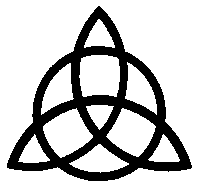Tattoo!!
 The symbol to the left is the triquetra. If I were to get a tattoo right now, it would be a dark purple triquetra. The original reason I wanted it was because of, surprise, surprise, ... Charmed. In the show, it stands for the Power of Three, the three sisters fighting evil together, as one. Below is an explanation of what else it means. (I got this from The Unicorn Shoppe website.)
The symbol to the left is the triquetra. If I were to get a tattoo right now, it would be a dark purple triquetra. The original reason I wanted it was because of, surprise, surprise, ... Charmed. In the show, it stands for the Power of Three, the three sisters fighting evil together, as one. Below is an explanation of what else it means. (I got this from The Unicorn Shoppe website.)The Triquetra & The Three Stages Of A Woman's Life
by Sorer X
A few months back, a mother and daughter were shopping at our store when the daughter, a precocious nine year old, happened to notice the Triquetra necklace which we keep on display in our necklace case. "Do you know what that means?" she asked.
"Yes, I do," I replied, and began to tell her everything I knew about this symbol, which was sacred to the ancient Celts. I didn't get very far into my spiel, however, before the girl interrupted me rather impatiently. "No!" she exclaimed. "It's 'the power of three!'"
Her mother and I had a little chuckle over this. Obviously, the little girl was a fan of the Charmed television series and, in her mind, "the power of three" was all she needed to know. The historic details and facts, so important to my adult mind, were boring and mystifying to her. As far as she was concerned, pop culture had summed it up nicely when it boiled the meaning of the Triquetra down to "the power of three."
Actually, the writers at the popular WB series have hit the nail squarely on the head with their simple definition of this symbol. The Triquetra, indeed, represents "the power of three."
To the ancient Celts, as well as to other pre-Christian Europeans, the number three was associated with the Goddess, and with femininity in general. This was due to their observation that one of the main things that women have in common is what they called "the three stages of a woman's life." These stages are unique to women, as they revolve around the menses.
The first stage is childhood, pre-menarche, before a girl has her first period. This stage is called "Virgin" or "Maiden." This is a carefree time, filled with fantasy and play – a time when consciousness is turned mainly on the self.
The second stage, the childbearing years, begins with the onset of menstruation. These are the "Mother" years, when consciousness turns outward, to the home and family.
The final stage, which begins at menopause, is called the "Crone" or "Wise Woman" stage. In this stage, consciousness is often turned both within and without. Traditionally, this is the time when women take leadership roles within their communities and are honored for the wisdom they have accumulated through the years.
"Virgin, mother, crone" or "maiden, mother, wise woman;" just as the three points of the Triquetra represent this concept, the association of this "power of three" is seen in other Pagan symbols as well. The Triple Moon, for example, illustrates these three stages nicely with the waxing, full and waning moons, with the increasing moon being the maiden, the full moon being the mother, and the decreasing moon being the wise old crone.
Unlike the Triple Moon, the Triquetra is not a pictorial representation drawn from what the ancients could see in the world around them. The Triquetra is a function of geometry and is created entirely with a compass. This creation of symbols using geometry is called "Sacred Geometry," a practice that dates all the way back to the ancient Egyptians. The pentagram, hexagram (Star of David), and the various Celtic crosses are all derived from Sacred Geometry.
Like most Sacred Geometry symbols, the Triquetra hides secrets within its structure. For example, the creation of the Triquetra also creates, integrated into its structure, three incidences of the "vesica pisces," another sacred geometrical symbol that contains within it "The Golden Mean" or "Golden Ratio." The Golden Mean is encoded within the DNA spiral and the vesica pisces is considered by some to be the most feminine of symbols.
©Copyright 2005 by AlternativeApproaches.com


8 Comments:
I think that would be a really cool tattoo. But I probably would do it in black . . .
Why??!!?
Because I think it would look better and it wouldn't fade as quickly. Plus, you're less likely to get tired of it if it's black. What if you stop liking purple?
Okay...........maybe black would be better.
I wasn't trying to change your mind. I was just trying to explain why I would do it differently. I think it would be cool in purple too.
I'd get one with you if you wanted.
What and where??!!?
This one and you tell me.
Post a Comment
<< Home